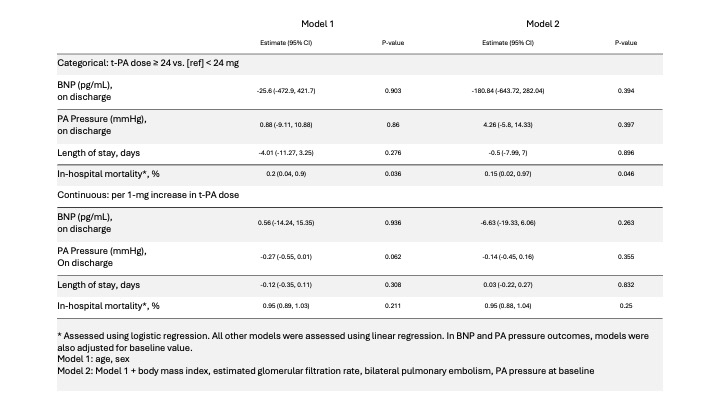Final ID: MDP143
Higher t-PA Doses are Associated with Reduced In-Hospital Mortality in Pulmonary Embolism Patients Undergoing Catheter-Directed Thrombolysis
Abstract Body (Do not enter title and authors here): Background: Pulmonary embolism (PE) is a leading cause of cardiovascular death and preventable hospital mortality in the US. High-risk acute PE has a 30% mortality rate, despite new treatments like catheter-directed thrombolytics (CDT). CDT has shown to improve right ventricle/left ventricle (RV/LV) diameter ratio compared to anticoagulation alone, but the optimal t-PA dose is uncertain. Traditional dosing is 10-24 mg over 12-24 hours, but clinical trials have showed similar RV/LV diameter ratio reductions with lower doses and shorter infusions. No prospective data has shown a mortality benefit.
Hypothesis: Higher t-PA doses will improve in-hospital mortality, length of stay (LOS), pulmonary artery (PA) pressure reduction, and cardiac biomarker reduction in patients receiving CDT for acute PE.
Methods: We retrospectively analyzed patients who presented with PE and underwent CDT at a single center, tertiary hospital. Patients were stratified by t-PA dose (<24mg vs ≥24mg). Outcomes were compared using adjusted linear or logistic regression models.
Results: Among 133 patients, 105 (80%) received t-PA ≥24mg. Patients who received higher doses of t-PA were younger (61 vs. 71 years, p=0.02), more likely to have bilateral PE (93% vs 77%; p=0.03) and had higher BMI (35 vs 30.5; p=0.04) and PA pressure (51 vs 40.5 mmHg; p=0.003) at baseline. In unadjusted analysis, no significant difference in in-hospital mortality was observed with t-PA ≥24mg (3.8% vs. 16.4%, p=0.08). However, in the adjusted analysis, a significantly lower risk in-hospital mortality rate was observed with t-PA ≥ 24mg (OR 0.15, 95%CI 0.02-0.97, p=0.046) (Table). No significant differences were observed in BNP reduction, PA pressure change, or LOS (Table).
Conclusion: In acute PE patients undergoing CDT, t-PA dosing ≥24mg was associated with reduced in-hospital mortality. Prospective randomized controlled trials are needed to further define optimal dosing protocols.
Hypothesis: Higher t-PA doses will improve in-hospital mortality, length of stay (LOS), pulmonary artery (PA) pressure reduction, and cardiac biomarker reduction in patients receiving CDT for acute PE.
Methods: We retrospectively analyzed patients who presented with PE and underwent CDT at a single center, tertiary hospital. Patients were stratified by t-PA dose (<24mg vs ≥24mg). Outcomes were compared using adjusted linear or logistic regression models.
Results: Among 133 patients, 105 (80%) received t-PA ≥24mg. Patients who received higher doses of t-PA were younger (61 vs. 71 years, p=0.02), more likely to have bilateral PE (93% vs 77%; p=0.03) and had higher BMI (35 vs 30.5; p=0.04) and PA pressure (51 vs 40.5 mmHg; p=0.003) at baseline. In unadjusted analysis, no significant difference in in-hospital mortality was observed with t-PA ≥24mg (3.8% vs. 16.4%, p=0.08). However, in the adjusted analysis, a significantly lower risk in-hospital mortality rate was observed with t-PA ≥ 24mg (OR 0.15, 95%CI 0.02-0.97, p=0.046) (Table). No significant differences were observed in BNP reduction, PA pressure change, or LOS (Table).
Conclusion: In acute PE patients undergoing CDT, t-PA dosing ≥24mg was associated with reduced in-hospital mortality. Prospective randomized controlled trials are needed to further define optimal dosing protocols.
More abstracts on this topic:
30-Day Outcomes of Dual vs Triple Antithrombotic Therapy After PCI
Meeks William, Slone Sarah, Barringhaus Kurt
A Novel Thrombolytic with Anti-inflammatory Properties (JX10) Improves Neurological Outcomes in Acute Lacunar Infarct up to 12 hours After OnsetChen Edmond, Niizuma Kuniyasu, Nitika Fnu, Hasumi Keiji, Tominaga Teiji, Nishimura Naoko, Zhang Shenglin

